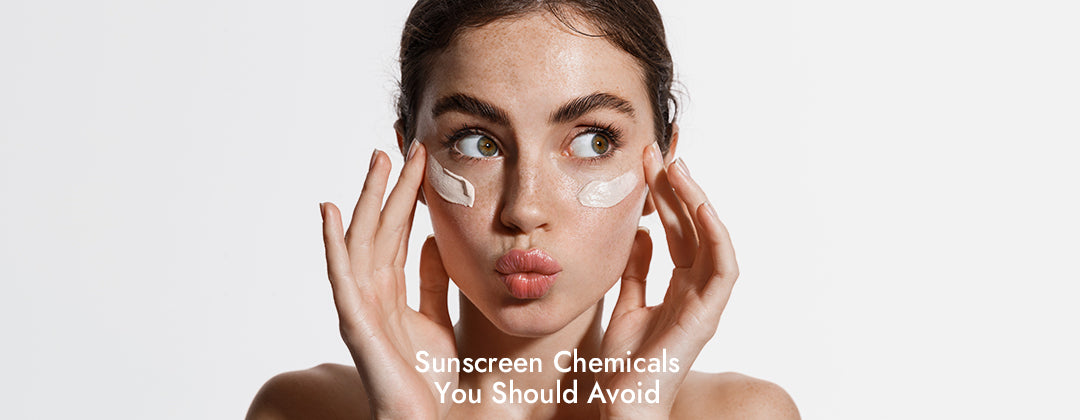Chemicals in Sunscreen to Avoid
by Lauren on Mar 08, 2023

Sunscreen is the first line of defense against the sun to help prevent UV damage, premature aging and reduce the risk of skin cancer. It is also made for daily use and to be re-applied multiple times a day, so using a product that is safe is an essential factor when choosing sunscreen.
Another important factor to note is the SPF (sun protection factor) of the sunscreen. The minimum recommendation is SPF 30 as it protects the skin from UVB rays, which cause a high risk of skin cancer and premature aging.
There are two main types of sunscreen available: physical/mineral sunscreen and chemical sunscreen.
But, What's the Difference?

Physical/Mineral Sunscreen
Physical sunscreen, also known as sunblock, acts as a physical barrier between the skin and UV rays. This type of sunscreen is not absorbed into the bloodstream and remains only on the skin’s surface. Therefore, mineral sunscreens should be applied in large amounts to get adequate protection, which can be an issue as this causes a white-tint on the skin and can also affect those with oily or acne-prone skin.
They are made with naturally occurring minerals, zinc oxide and titanium dioxide, which form a UV filter over the skin but it is important to avoid spray types due to health risks caused by inhalation. However, overall, mineral sunscreens are deemed safer to use due to the minimal risks involved with liquid, application-type sunscreen and they provide adequate protection against harmful UV rays yet are not absorbed into the bloodstream, unlike chemical sunscreen.
Chemical Sunscreen
A chemical sunscreen acts as a ‘sponge’ by absorbing UV rays and converting them into heat. Whilst chemical sunscreens are also effective at protecting the skin from harmful UV rays, they are often formulated with harsh chemicals which are taken up into the bloodstream, posing a potential health risk for users.
These harsh chemicals that should be avoided when selecting a sunscreen include:

Oxybenzone
Listed as the most harmful of the to-be-avoided chemicals, oxybenzone causes coral bleaching when washed into the ocean and reacts with swimming pool chlorine and releases toxic, insoluble substances into the water. In addition to harming wildlife, it can also cause hormonal imbalances and has been linked to breast cancer and endometriosis.
Avobenzone
It is less toxic than oxybenzone, however, it is unstable and therefore degenerates when exposed to sunlight - releasing free radicals which speed up aging and can have harmful health consequences.
Homosalate
Homosalate is a common ingredient in many sunscreens as an organic UV filter, preventing UV rays from reaching skin. However, homosalate has been found to penetrate the skin, causing hormone disruption and producing toxic byproducts. It has been suggested that its use is safe to a maximum concentration of 1.4%, however, the FDA permits sunscreens to contain up to concentration of 15%.
Octinoxate
As a UV filter that can be absorbed by the skin, similarly to oxybenzone, and continues to be absorbed after the sunscreen has been applied. Research showed that this chemical affects metabolic and thyroid hormones.
Octocrylene
This chemical has been found to not only cause fairly high rates of skin allergies, but also has been linked to aquatic toxicity and is often contaminated with benzophenone, known to cause cancer.
Meradimate
This chemical is currently waiting for FDA approval and is under review. It has been banned in Europe and Japan on the premise of its potential risks to humans and the environment.
Other chemicals linked to causing health and environmental risks include:
- Padimate O
- Cinoxate
- Dioxybenzone
- Ensulizole
- Sulisobenzone
Finding a safe sunscreen may seem like a difficult task with many potent chemicals to avoid. But, the overall take-away is to best avoid chemical sunscreens, particularly those containing these potentially-harmful ingredients and opt for a physical/mineral sunscreen.
Some mineral sunscreens which are safe-to-use and all SPF 50+ PA++++ include:
I’m From - Rice Sunscreen
This mineral sunscreen contains Zinc Oxide to act as a physical barrier between the sun and your skin and does not contain any of the harmful chemicals listed above.
Rovectin - Aqua Soothing UV Protector
Formulated with Zinc Oxide and Titanium Dioxide, it protects your skin yet is even suitable for oily/combination skin.
Chasin’ Rabbits - G’day Mate Sunscreen
This sunscreen is also formulated with Zinc Oxide and Titanium Dioxide and is also formulated with plant-derived ‘fermented Inca Inchi oil’ to improve the consistency of the product, making it easier to blend and reduce white-cast.












